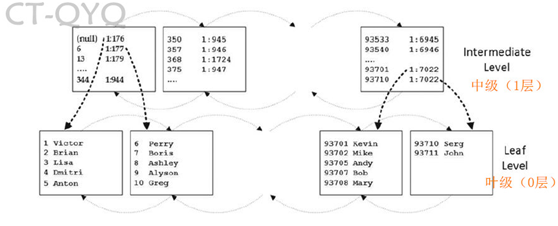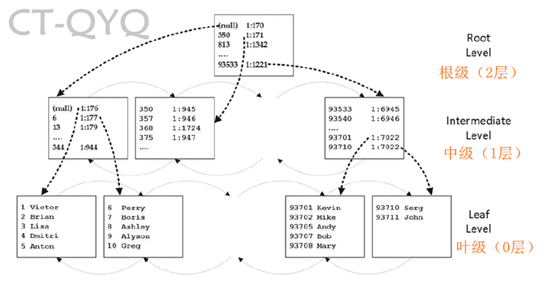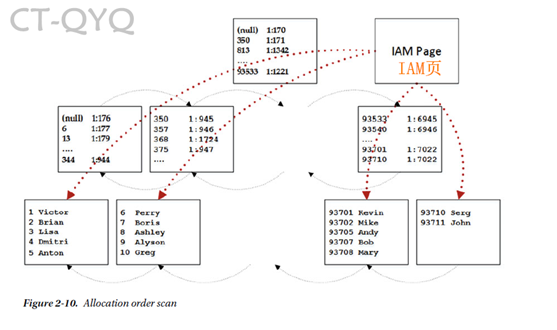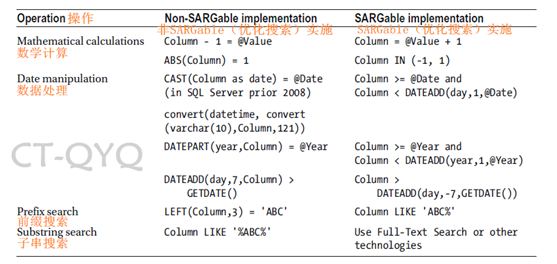翻譯之聚集索引
Clustered Indexes
聚集索引
文章選自:《Pro SQL Server Internals, 2nd edition》CHAPTER 2 Tables and Indexes
作者:Dmitri Korotkevitch
A clustered index dictates the physical order of the data in a table, which is sorted according to the clustered index key. The table can have only one clustered index defined. Let’s assume that you want to create a clustered index on the heap table with the data. As a first step, which is shown in Figure 2-5 , SQL Server creates another copy of the data that is then sorted based on the value of the clustered key. The data pages are linked in a double-linked list where every page contains pointers to the next and previous pages in the chain. This list is called the leaf level of the index, and it contains the actual table data.
聚集索引表示表中資料的物理順序,根據聚集索引鍵排序。表僅可以定義一個聚集索引。我們假設你想要在堆表的資料上建立群索引。第一步,如圖2-5所示,SQLServer建立了另一個數據副本。然後根據群集金鑰的值對其進行排序。資料每個頁面中包含的雙鏈表中的頁面連結指向鏈中下一頁和上一頁的指標。此列表被呼叫索引的葉子級別,其中包含實際的表資料。
Figure 2-5. Clustered index structure: Leaf level
表2-5. 索引的結構:葉子級別

■ Note The sort order on the page is controlled by a slot array. Actual data on the page is unsorted.
注意:頁面上的排序順序由插槽陣列控制。頁面上的實際資料未排序。
When the leaf level consists of multiple pages, SQL Server starts to build an intermediate level of the index, as shown in Figure 2-6 .
當葉子級別由多個頁面組成時,SQL Server開始構建索引的中間級別,如圖2-6所示。

F igure 2-6. Clustered index structure: Intermediate and leaf levels
圖2-6。聚集索引的結構:中間級別和葉子級別
The intermediate level stores one row per leaf-level page. It stores two pieces of information: the physical address and the minimum value of the index key from the page it references. The only exception is the very first row on the first page, where SQL Server stores NULL rather than the minimum index key value. With such optimization, SQL Server does not need to update non-leaf-level rows when you insert the row with the lowest key value in the table. The pages on the intermediate levels are also linked to the double-linked list. SQL Server adds more and more intermediate levels until there is a level that includes just the single page. This level is called the root level , and it becomes the entry point to the index, as shown in Figure 2-7 .
中間級別為每個葉級頁面儲存一行。它儲存兩條資訊:實體地址和引用的頁面中的索引鍵的最小值。唯一的例外是第一頁上的第一行,其中SQL Server儲存NULL而不是最小索引鍵值。有了這樣的優化,SQL插入時,伺服器不需要更新非葉子級別行表中鍵值最小的行。頁面的中間級別也連結到雙鏈表。 SQL伺服器新增越來越多的中間級別,直到有一個僅包括單頁級別。此級別稱為根級別,它成為索引的入口點,如圖所示圖2-7。

F igure 2-7. Clustered index structure: Root level
圖2-7. 聚集索引結構:跟級別
As you can see, the index always has one leaf level, one root level, and zero or more intermediate levels. The only exception is when the index data fits into a single page. In that case, SQL Server does not create the separate root-level page, and the index consists of just the single leaf-level page. The number of levels in the index largely depends on the row and index key sizes. For example, the index on the 4-byte integer column will require 13 bytes per row on the intermediate and root levels. Those 13 bytes consist of a 2-byte slot-array entry, a 4-byte index-key value, a 6-byte page pointer, and a 1-byte row overhead, which is adequate because the index key does not contain variable-length and NULL columns. As a result, you can accommodate 8,060 bytes / 13 bytes per row = 620 rows per page. This means that, with the one intermediate level, you can store information about up to 620 * 620 = 384,400 leaf-level pages. If your data row size is 200 bytes, you can store 40 rows per leaf-level page and up to 15,376,000 rows in the index with just three levels. Adding another intermediate level to the index would essentially cover all possible integer values.
如您所見,索引始終有一個葉子級別,一個根級別,和零個或多箇中間級別。唯一的不同是什麼時候索引資料適合單個頁面。在這種情況下,SQL Server不會建立單獨的根級別頁面,索引由單葉子級別頁面組成。索引中的級別數量主要取決於行和索引鍵大小。例如,索引就可以了4位元組整數列每行需要13個位元組中級和根級。這13個位元組由一個2位元組的插槽組成 陣列條目,4位元組索引鍵值,6位元組頁面指標和1-位元組行開銷,這是足夠的,因為索引鍵沒有包含可變長度和NULL列。結果,你可以容納8,060位元組/每行13位元組=每頁620行。這意味著,通過一箇中間級別,您可以儲存資訊大約620 * 620 = 384,400個葉子級頁面。如果資料行大小為200位元組,每個葉級頁面最多可儲存40行索引中有15,376,000行,只有三個級別。新增另一個指數的中間級別基本上涵蓋所有可能的整數值。
■ Note In real life, index fragmentation would reduce those numbers. We will talk about index fragmentation in Chapter 6
注意:在現實生活中,索引碎片會減少這些碎片數字。我們將在第6章討論索引碎片。
.
There are three different ways in which SQL Server can read data from the index. The first one is by an ordered scan. Let’s assume that we want to run the SELECT Name FROM dbo.Customers ORDER BY CustomerId query. The data on the leaf level of the index is already sorted based on the CustomerId column value. As a result, SQL Server can scan the leaf level of the index from the first to the last page and return the rows in the order in which they were stored.
SQL Server可以通過三種不同的方式從中讀取資料指數。第一個是有序掃描。讓我們假設
我們想要執行SELECT Name FROM dbo.Customers ORDER BY CustomerId查詢。索引的葉級別上的資料已經基於排序在CustomerId列值上。因此,SQL Server可以掃描索引的葉級從第一頁到最後一頁並返回行按儲存順序排列。
SQL Server starts with the root page of the index and reads the first row from there. That row references the intermediate page with the minimum key value from the table. SQL Server reads that page and repeats the process until it finds the first page on the leaf level. Then, SQL Server starts to read rows one by one, moving through the linked list of the pages until all rows have been read. Figure 2-8 illustrates this process.
SQL Server從索引的根頁開始並從中讀取第一行。該行引用了中間頁面表中的最小鍵值。 SQL Server讀取該頁面和重複該過程,直到找到葉子級別的第一頁。然後,SQL Server開始逐個讀取行,通過連結列表的頁面,直到讀取所有行。圖2-8說明了這個過程。

Figure 2-8. Ordered index scan
圖2-8。有序索引掃描
The execution plan for the preceding query shows the Clustered Index Scan operator with the Ordered property set to true, as shown in Figure 2-9 .
上一個查詢顯示了聚集索引將Ordered屬性設定為true的運算,如下圖2-9所示。

Figure 2-9. Ordered index scan execution plan
圖2-9。有序索引掃描執行計劃
I t is worth mentioning that the order by clause is not required for an ordered scan to be triggered. An ordered scan just means that SQL Server reads the data based on the order of the index key. SQL Server can navigate through indexes in both directions, forward and backward. However, there is one important aspect that you must keep in mind: SQL Server does not use parallelism during backward index scans.
值得一提的是,排序不是必需的要觸發的有序掃描。有序掃描只意味著SQL伺服器根據索引鍵的順序讀取資料。SQL Server可以向前和向後掃描兩個方向的索引。但是,必須牢記一個重要方面:SQL在反向索引掃描期間,伺服器不使用並行性。
■ Tip Y ou can check scan direction by examining the INDEX SCAN or INDEX SEEK operator properties in the execution plan. Keep in mind, however, that Management Studio does not display these properties in the graphical representation of the execution plan. You need to open the Properties window to see it by selecting the operator in the execution plan and choosing the View/Properties Window menu item or by pressing the F4 key.
注意:您可以通過檢查索引掃描來檢查掃描方向或執行計劃中的索引運算子屬性。但是,請注意,Management Studio不會顯示這些內容執行計劃的圖形表示中的屬性。您需要開啟“屬性”視窗以通過選擇運算子來檢視它在執行計劃中並選擇“檢視/屬性視窗”選單專案或按F4鍵。
The Enterprise Edition of SQL Server has an optimization feature called merry-go-round scan that allows multiple tasks to share the same index scan. Let’s assume that you have session S1, which is scanning the index. At some point in the middle of the scan, another session, S2, runs a query that needs to scan the same index. With a merry-go-round scan, S2 joins S1 at its current scan location. SQL Server reads each page only once, passing rows to both sessions.
SQL Server企業版具有優化的功能稱為旋轉木馬掃描,允許多個任務共享相同的索引掃描。讓我們假設您有會話S1,即掃描索引。在掃描中間的某個點,另一個會話S2執行需要掃描相同索引的查詢。有了旋轉木馬掃描,S2在其當前掃描位置加入S1。 SQL伺服器只讀取每個頁面一次,將行傳遞給兩個會話。
When the S1 scan reaches the end of the index, S2 starts scanning data from the beginning of the index until the point where the S2 scan started. A merry-go-round scan is another example of why you cannot rely on the order of the index keys and why you should always specify an ORDER BY clause when it matters.
The next access method after the ordered scan is called an allocation order scan. S QL Server accesses the table data through the IAM pages, similar to how it does so with heap tables. The SELECT Name FROM dbo.Customers WITH (NOLOCK) query and Figure 2-10 illustrate this method. Figure 2-11 shows the query execution plan.
當S1掃描到達索引的結束時,S2從索引的開始開始掃描資料,直到S2掃描開始的點。旋轉木馬掃描是另一個示例,它說明了為什麼您不能依賴於索引鍵的順序,以及為什麼在需要時應該始終指定ORDER BY子句。排序掃描之後的下一個訪問方法稱為分配順序掃描。S QL Server通過IAM頁面訪問表資料,類似於使用堆表的方式。SELECT Name from dbo.Customers WITH(NOLOCK)查詢和圖2-10說明了這種方法。圖2-11顯示了查詢執行計劃。

Figure 2-10. Allocation order scan
圖2-10。分配順序掃描

Figure 2-11. A llocation order scan execution plan
圖2-11。分配順序掃描執行計劃
Unfortunately, it is not easy to detect when SQL Server uses an allocation order scan. Even though the Ordered property in the execution plan shows false , it indicates that SQL Server does not care whether the rows were read in the order of the index key, not that an allocation order scan was used.
不幸的是,SQL Server使用時很難檢測分配順序掃描。即使在Ordered屬性的執行計劃顯示false,表示SQL Server不關心是否按索引鍵的順序讀取行,而不是使用了分配訂順序掃描。
An allocation order scan can be faster for scanning large tables, although it has a higher startup cost. SQL Server does not use this access method when the table is small. Another important consideration is data consistency. SQL Server does not use forwarding pointers in tables that have a clustered index, and an allocation order scan can produce inconsistent results. Rows can be skipped or read multiple times due to the data movement caused by page splits. As a result, SQL Server usually avoids using allocation order scans unless it reads the data in READ UNCOMMITTED or SERIALIZABLE transaction-isolation levels.
The execution plan is shown in Figure 2-13 .
掃描大表時,分配順序掃描可以更快,雖然它具有更高的啟動成本。 當表很小時SQL Server不使用它當訪問方法。另一個重要的考慮是資料一致性。SQL Server不使用轉發指標,具有聚集索引的表和分配順序掃描可以產生不一致的結果。由於分頁導致的資料移動,可以多次跳過或讀取行。因此,SQLServer通常避免使用分配順序掃描。除非它以READ UNCOMMITTED或SERIALIZABLE事務隔離級別讀取資料。
■ Note We will talk about page splits and fragmentation in Chapter 6 , “Index Fragmentation,” and discuss locking and data consistency in Part III, “Locking, Blocking, and Concurrency.”
注意:我們將在第6章“索引分段”中討論分頁和分段,在第三部分“鎖定、阻塞和併發”中討論鎖定和資料一致性。
The last index access method is called index seek . The SELECT Name FROM dbo.Customers WHERE CustomerId BETWEEN 4 AND 7 query and Figure 2-12 illustrate the operation
最後一個索引訪問方法稱為索引查詢。 SELECT名稱FROM dbo.Customers WHERE CustomerId BETWEEN 4 AND 7查詢.圖2-12說明了該操作

Figure 2-12. Index seek
圖2-12。索引查詢
In order to read the range of rows from the table, SQL Server needs to find the row with the minimum value of the key from the range, which is 4. SQL Server starts with the root page, where the second row references the page with the minimum key value of 350. It is greater than the key value that we are looking for (4), and SQL Server reads the intermediate-level data page (1:170) referenced by the first row on the root page.
為了從表中讀取行的範圍,SQL Server需要從範圍中找到具有最小鍵值的行是4. SQL Server以根頁面開始,其中第二行引用最小鍵值為350的頁面。它大於我們要查詢的鍵值(4),並且SQL Server讀取根頁面上第一行引用的中間級資料頁(1:170)。
Similarly, the intermediate page leads SQL Server to the first leaf-level page (1:176). SQL Server reads that page, then it reads the rows with CustomerIds equal to 4 and 5, and, finally, it reads the two remaining rows from the second page.
同樣,中間頁面將SQL Server引向第一個葉子 - 級別頁面(1:176)。 SQL Server讀取該頁面,然後讀取行CustomerIds等於4和5,最後,它讀取兩個第二頁的剩餘行。
執行計劃如圖2-13所示。

Figure 2-13. Index seek execution plan
圖2-13。索引查詢執行計劃
As you can guess, index seek is more efficient than index scan, because SQL Server processes just the subset of rows and data pages rather than scanning the entire table.
您可以猜測,索引搜尋比索引掃描更有效,因為SQL Server只處理行和資料頁的子集,而不是掃描整個表。
Technically speaking, there are two kinds of index seek operations. The first is called a singleton lookup , or sometimes point-lookup , where SQL Server seeks and returns a single row. You can think about WHERE CustomerId = 2 predicate as an example. The other type of index seek operation is called a range scan , and it requires SQL Server to find the lowest or highest value of the key and scan (either forward or backward) the set of rows until it reaches the end of scan range. The predicate WHERE CustomerId BETWEEN 4 AND 7 leads to the range scan. Both cases are shown as INDEX SEEK operations in the execution plans.
從技術上講,索引搜尋操作有兩種。第一種稱為單例查詢,有時稱為點查詢,其中SQL Server尋找並返回單行。您可以考慮將WHERE CustomerId = 2謂詞作為示例。另一種型別的索引查詢操作稱為範圍掃描,它要求SQL Server查詢鍵的最低值或最高值,並掃描(向前或向後)行集,直到達到掃描範圍的末尾。 CustomerId BETWEEN 4和7之間的謂詞WHERE導致範圍掃描。這兩種情況都在執行計劃中顯示為INDEX SEEK操作。
As you can guess, it is entirely possible for range scans to force SQL Server to process a large number or even all data pages from the index. For example, if you changed the query to use a WHERE CustomerId > 0 predicate, SQL Server would read all rows/pages, even though you would have an Index Seek operator displayed in the execution plan. You must keep this behavior in mind and always analyze the efficiency of range scans during query performance tuning.
可以猜到,範圍掃描完全可以強制SQL Server處理索引中的大量甚至所有資料頁。例如,如果您將查詢更改為使用WHERE CustomerId> 0謂詞,則SQL Server將讀取所有行/頁,即使您在執行計劃中顯示了Index Seek運算子。您必須牢記此行為,並始終在查詢效能調整期間分析範圍掃描的效率。
There is a concept in relational databases called SARGable predicates , which stands for S earch Argumentable . The predicate is SARGable if SQL Server can utilize an index seek operation, if an index exists. In a nutshell, predicates are SARGable when SQL Server can isolate the single value or range of index key values to process, thus limiting the search during predicate evaluation. Obviously, it is beneficial to write queries using SARGable predicates and utilize index seek whenever possible. SARGable predicates include the following operators: = , > , >= , < , <= , IN , BETWEEN , and LIKE (in case of prefix matching). Non-SARGable operators include NOT , <> , LIKE (in case of non-prefix matching), and NOT IN . Another circumstance for making predicates non-SARGable is using functions or mathematical calculations against the table columns. SQL Server has to call the function or perform the calculation for every row it processes. Fortunately, in some of cases you can refactor the queries to make such predicates SARGable. Table 2-1 shows a few examples of this.
關係資料庫中有一個名為SARGable謂詞的概念,它代表Search Argumentable。如果索引存在,如果SQL Server可以使用索引查詢操作,則謂詞是SARGable。簡而言之,當SQL Server可以隔離要處理的索引鍵值的單個值或範圍時,謂詞是SARGable,因此在謂詞評估期間限制搜尋。顯然,使用SARGable謂詞編寫查詢並儘可能利用索引查詢是有益的。 SARGable謂詞包括以下運算子:=,>,> =,<,<=,IN,BETWEEN和LIKE(在字首匹配的情況下)。非SARGable運算子包括NOT,<>,LIKE(在非字首匹配的情況下)和NOT IN。使謂詞非SARGable的另一種情況是對錶列使用函式或數學計算。 SQL Server必須為其處理的每一行呼叫該函式或執行計算。幸運的是,在某些情況下,您可以重構查詢以使這樣的謂詞成為SARGable。
表2-1列出了一些例子。
Table 2-1. Examples of Refactoring Non-SARGable Predicates into SARGable Ones
表2-1。 將非SARGable謂詞重構為SARGable的示例

Another important factor that you must keep in mind is type conversion . In some cases, you can make predicates non-SARGable by using incorrect data types. Let’s create a table with a varchar column and populate it with some data, as shown in Listing 2-6 .
Listing 2-6. SARG predicates and data types: Test table creation
另一個重要因素是型別轉換。 在某些情況下,您可以使用不正確的資料型別使謂詞非SARGable。讓我們建立一個帶有varchar列的表,並用一些資料填充它,如清單2-6所示。
清單2-6 SARG謂詞和資料型別:測試表建立
create table dbo.Data
(
VarcharKey varchar(10) not null,
Placeholder char(200)
);
create unique clustered index IDX_Data_VarcharKey
on dbo.Data(VarcharKey);
;with N1(C) as (select 0 union all select 0) -- 2 rows
,N2(C) as (select 0 from N1 as T1 cross join N1 as T2) -- 4 rows
,N3(C) as (select 0 from N2 as T1 cross join N2 as T2) -- 16 rows
,N4(C) as (select 0 from N3 as T1 cross join N3 as T2) -- 256 rows
,N5(C) as (select 0 from N4 as T1 cross join N4 as T2) -- 65,536 rows
,IDs(ID) as (select row_number() over (order by (select null)) from N5)
insert into dbo.Data(VarcharKey)
select convert(varchar(10),ID) from IDs;
The clustered index key column is defined as varchar , even though it stores integer values. Now, let’s run two selects, as shown in Listing 2-7 , and look at the execution plans.
聚集索引鍵列定義為varchar,用它儲存整數值。現在,讓我們執行兩個選擇,如清單2-7所示,並檢視執行計劃。
Listing 2-7. SARG predicates and data types: Select with integer parameter
清單2-7 SARG謂詞和資料型別:選擇使用整數引數
declare
@IntParam int = '200'
select * from dbo.Data where VarcharKey = @IntParam;
select * from dbo.Data where VarcharKey = convert(varchar(10),@IntParam);
As you can see in Figure 2-14 , in the case of the integer parameter, SQL Server scans the clustered index, converting varchar to an integer for every row. In the second case, SQL Server converts the integer parameter to a varchar at the beginning and utilizes a much more efficient clustered index seek operation.
如圖2-14所示,對於整數引數,SQL Server掃描聚簇索引,將varchar轉換為每行的整數。 在第二種情況下,SQL Server在開始時將整數引數轉換為varchar,並使用更高效的聚簇索引查詢操作。

Figure 2-14. SARG predicates and data types: Execution plans with integer parameter
圖2-14。 SARG謂詞和資料型別:帶整數引數的執行計劃
■ Tip Pay attention to the column data types in the join predicates. Implicit or explicit data type conversions can significantly decrease the performance of the queries.
注意:請注意連線謂詞中的列資料型別。 隱式或顯式資料型別轉換可能會顯著降低查詢的效能。
You will observe very similar behavior in the case of unicode string parameters. Let’s run the queries shown in Listing 2-8 . Figure 2-15 shows the execution plans for the statements.
在unicode字串引數的情況下,您將觀察到非常類似的行為。 讓我們執行清單2-8中所示的查詢。 圖2-15顯示了語句的執行計劃。
Listing 2-8. SARG predicates and data types: Select with string parameter
清單2-8 SARG謂詞和資料型別:使用字串引數選擇
select * from dbo.Data where VarcharKey = '200';
select * from dbo.Data where VarcharKey = N'200'; -- unicode parameter
As you can see, a unicode string parameter is non-SARGable for varchar columns. This is a much bigger issue than it appears to be. While you rarely write queries in this way, as shown in Listing 2-8 , most application development environments nowadays treat strings as unicode. As a result, SQL Server client libraries generate unicode ( nvarchar ) parameters for string objects unless the parameter data type is explicitly specified as varchar . This makes the predicates non-SARGable, and it can lead to major performance hits due to unnecessary scans, even when varchar columns are indexed.
如您所見,對於varchar列,unicode字串引數是非SARGable。 這是一個比看起來更大的問題。 雖然您很少以這種方式編寫查詢,如清單2-8所示,但現在大多數應用程式開發環境都將字串視為unicode。 因此,除非將引數資料型別顯式指定為varchar,否則SQL Server客戶端庫會為字串物件生成unicode(nvarchar)引數。 這使得謂詞不具有SARG,並且由於不必要的掃描,它可能導致主要的效能命中,即使對varchar列進行索引也是如此。
■ Important Always specify parameter data types in client applications. For example, in ADO.Net, use
注意:始終在客戶端應用程式中指定引數資料類 例如,在ADO.Net中使用
You will observe very similar behavior in the case of unicode string parameters. Let’s run the queries shown in Listing 2-8 . Figure 2-15 shows the execution plans for the statements.
Listing 2-8. SARG predicates and data types: Select with string parameter
在unicode字串引數的情況下,您將觀察到非常類似的行為。執行清單2-8中所示的查詢。 圖2-15顯示了語句的執行計劃。
清單2-8 SARG謂詞和資料型別:使用字串引數選擇
select * from dbo.Data where VarcharKey = '200';
select * from dbo.Data where VarcharKey = N'200'; -- unicode parameter

Figure 2-15. S ARG predicates and data types: Execution plans with s tring parameter
圖2-15。 S ARG謂詞和資料型別:帶有引數的執行計劃
As you can see, a unicode string parameter is non-SARGable for varchar columns. This is a much bigger issue than it appears to be. While you rarely write queries in this way, as shown in Listing 2-8 , most application development environments nowadays treat strings as unicode. As a result, SQL Server client libraries generate unicode ( nvarchar ) parameters for string objects unless the parameter data type is explicitly specified as varchar . This makes the predicates non-SARGable, and it can lead to major performance hits due to unnecessary scans, even when varchar columns are indexed.
如您所見,對於varchar列,unicode字串引數是非SARGable。 這是一個比看起來更大的問題。 雖然您很少以這種方式編寫查詢,如清單2-8所示,但現在大多數應用程式開發環境都將字串視為unicode。 因此,除非將引數資料型別顯式指定為varchar,否則SQL Server客戶端庫會為字串物件生成unicode(nvarchar)引數。 這使得謂詞不具有SARG,並且由於不必要的掃描,它可能導致不能搜尋,即使對varchar列進行索引也是如此。
■ Important Always specify parameter data types in client applications. For example, in ADO.Net, use
注意:始終在客戶端應用程式中指定引數資料類 例如,在ADO.Net中使用
Parameters.Add("@ParamName",SqlDbType.Varchar, <Size>).Value = stringVariable instead of
Parameters.Add("@ParamName").Value = stringVariable overload.
Use mapping in ORM frameworks to explicitly specify non-unicode attributes in the classes.
在ORM框架中使用對映來顯式指定類中的非unicode屬性。
It is also worth mentioning that varchar parameters are SARGable for nvarchar unicode data columns.
值得一提的是,對於nvarchar unicode資料列,varchar引數是SARGable。
